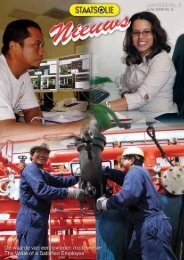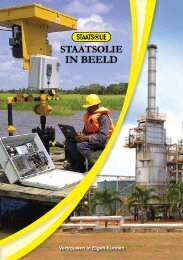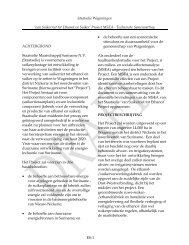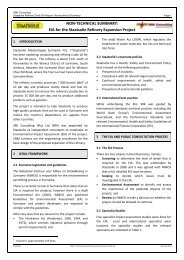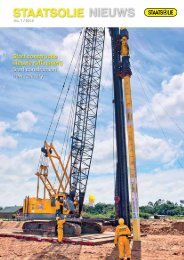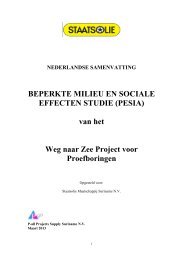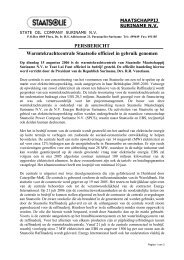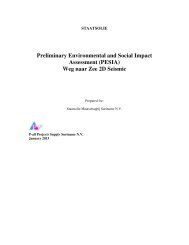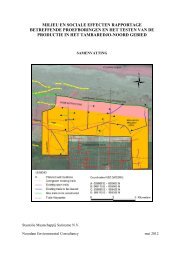concept EIA-rapport - Staatsolie
concept EIA-rapport - Staatsolie
concept EIA-rapport - Staatsolie
Create successful ePaper yourself
Turn your PDF publications into a flip-book with our unique Google optimized e-Paper software.
SRK Consulting: Project No: 439414 <strong>Staatsolie</strong> Pipeline <strong>EIA</strong> – Draft <strong>EIA</strong> Report Page 36<br />
• All sampled drainage canals in Greater Paramaribo have high to very high concentrations of<br />
coliforms, indicating bacterial contamination, most likely from septic systems. Coliform<br />
concentrations decrease further away from the source due to dilution and bacterial breakdown.<br />
The same trend is observed for organic matter, Biological Oxygen Demand, Chemical Oxygen<br />
Demand, total nitrogen, ammonium and chlorophyll-a;<br />
• The level of coliforms may pose a threat to health when water contact occurs during swimming<br />
or flooding; and<br />
• Concentrations of heavy metals, particularly mercury, lead, cadmium and zinc, are relatively high<br />
at many locations in the Paramaribo drainage system. These are thought to be caused by<br />
industry, waste dumping, discarded batteries and car wrecks.<br />
Specific water quality problems identified for the drainage areas within the study area are described<br />
in Table 4-8.<br />
Table 4-8: Water quality problems identified in the study area<br />
Area Identified water quality problems<br />
Beekhuizen • Low oxygen level and elevated nutrient levels<br />
• High concentration of heavy metals in the bottom sediment, (especially mercury, zinc and<br />
copper, with moderate levels of lead), possibly related to the former Bruynzeel wood<br />
processing industry and/or the dumping of wood ashes at open areas of the Bruynzeel site<br />
• Expected high level of coliforms, given the generally high to very high concentrations of<br />
coliforms in Paramaribo<br />
Livorno • Very low oxygen level<br />
• Oil observed in the water during three of four sampling rounds<br />
• High concentrations of coliforms<br />
Tout Lui Faut • Low oxygen level<br />
Saramacca<br />
Canal<br />
4.1.5.2 Groundwater<br />
• No visible contamination reported<br />
• Expected high level of coliforms, given the generally high to very high concentrations of<br />
coliforms in Paramaribo<br />
• High disturbance of canal by human activities<br />
• Elevated nutrient levels<br />
• High concentrations of coliforms in the water<br />
• Elevated heavy metal concentrations (particularly mercury, lead and zinc) in water and<br />
bottom sediment<br />
The study area is underlain by three major aquifers within the Corantijn Group (see Figure 4-10):<br />
• The A-sand aquifer (in the Burnside Formation) contains freshwater in many locations, including<br />
Paramaribo and the pipeline area. It is found here at approximate depths between 120 and<br />
160 m. The aquifer thickness varies from 10-60 m. The A-Sand aquifer is not directly recharged<br />
by rainwater, and it is suspected that upward leakage of groundwater from the older, underlying<br />
formation is likely;<br />
• The Coesewijne aquifer contains freshwater in many locations of the coastal plain, including<br />
Paramaribo and the pipeline area. The top of the aquifer is found at a depth of 70 m at<br />
Paramaribo and slightly less deep in the pipeline area. The Coesewijne sands are in hydraulic<br />
contact with the overlying Zanderij Formation, with groundwater flow in the southern Young<br />
Coastal Plain (Helena Christina road – Lelydorp) and diffusion in the northern Young Coastal<br />
Plain; and<br />
REUT/DALC 439414_<strong>Staatsolie</strong>Pipeline<strong>EIA</strong>_Draft <strong>EIA</strong> Report_Final June 2012




